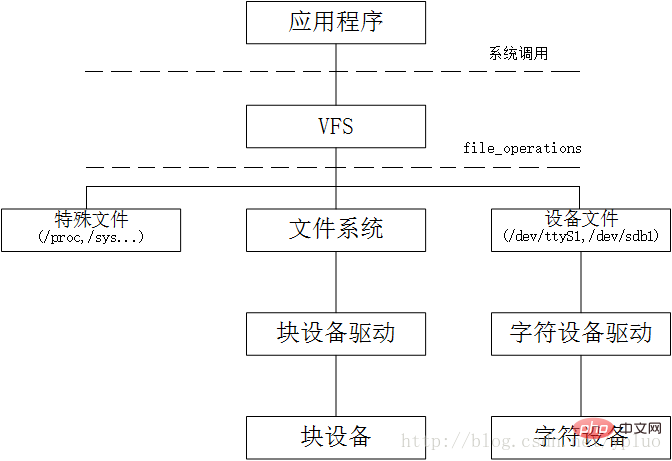 Operation and Maintenance
Operation and Maintenance
 Linux Operation and Maintenance
Linux Operation and Maintenance
 What are the linux character devices?
What are the linux character devices?
What are the linux character devices?
Linux character devices include: 1. The mouse is an external input device for the computer and an indicator for positioning the vertical and horizontal coordinates of the computer display system; 2. The keyboard is an instruction used to operate the computer device. and data input device; 3. Serial port terminal, a terminal device connected using a computer serial port; 4. Control terminal; 5. Console, etc.

#The operating environment of this tutorial: linux5.9.8 system, Dell G3 computer.
In order to facilitate management, the Linux system divides devices into three basic types:
Character device
Block device
Network devices
They are all displayed in the /dev directory of the file system in the form of a file node (crw--w---- 1 root tty 4, 0 July 11 09:11 tty0 where c represents the character device type).
linux character device
Character device refers to a device that can be read and written directly without buffering, such as mouse, keyboard, and serial port device , modem, etc. The difference from block devices is that the basic unit of character operations is bytes.
Classification of character devices
Character devices mainly include control terminal equipment and serial terminal equipment, such as consoles and keyboards. Based on differences in functions and hardware, character terminal devices are classified as follows:
Serial port terminal (/dev/ttSn): A terminal device connected using a computer serial port, serial The device data transmission method is 8-bit single-line transmission of the same character. Enter echo 'hello world' > /dev/ttyS0 on the command line to write the input to the corresponding device.
Pseudo terminal (/dev/ttyp, /dev/ptyp): Corresponding to the fact that there is no real hardware device at the bottom layer, it is used to provide a terminal-style interface for other programs, such as network login to the host. A terminal interface between a network server and a shell program.
Control terminal (/dev/tty): The main device number is 5. The process control terminal is associated with the process. For example, the login shell process uses the terminal /dev/tty.
Console (/dev/ttyn,/dev/consol): The monitor for computer input and output. When the console is logged in, tty1 is used, while the ubuntu graphical interface uses tty7 .
Other types: Current Linux has many other types of device special files for many different devices, such as the /dev/ttyIn device of the ISIDIN device.
The following is a schematic diagram of the structure of the character device

The nature and characteristics of the character device
Character device is a type of device file system, which is equivalent to the logical device file provided by the underlying hardware to the upper layer. It is like connecting a data port (data register) to a file, and the device driver directly accesses the file. operation, so the read and write operations were directly performed on the port. Also as a file, the character device driver must also implement the basic operations of files such as open(), close(), write(), read(), etc. Of course, terminal redirection operations are also supported.
Character device file files are read and written in single byte units, and there is no need to set up a hardware buffer. The device is accessed by the operating system as a byte stream. The byte stream is like setting up a transmission pipe between the hardware port and the file system. Bytes are transmitted through the pipe one by one and presented to both readers and writers. This streaming feature is implemented in the driver as a buffer queue. For example: The read-write buffer queue in the console structure
struct tty_struct {
struct termios termios;
int pgrp;
int stopped;
void (*write)(struct tty_struct * tty);
struct tty_queue read_q; //读队列
struct tty_queue write_q; //写队列
struct tty_queue secondary; //tty辅助队列(存放规格化后的字符)
};character device is identified by the character device number. The character device number consists of a major device number and a minor device number. For example, the device number of /dev/ttyS0 is (4, 64); the major device number identifies the driver corresponding to the device, and the kernel uses the major device number to match the device and the driver one-to-one. Generally speaking, the minor device number is used by the driver for the code used internally by the driver to differentiate between device details. It is not used by other parts of the kernel.
Related recommendations: "Linux Video Tutorial"
The above is the detailed content of What are the linux character devices?. For more information, please follow other related articles on the PHP Chinese website!

Hot AI Tools

Undresser.AI Undress
AI-powered app for creating realistic nude photos

AI Clothes Remover
Online AI tool for removing clothes from photos.

Undress AI Tool
Undress images for free

Clothoff.io
AI clothes remover

Video Face Swap
Swap faces in any video effortlessly with our completely free AI face swap tool!

Hot Article

Hot Tools

Notepad++7.3.1
Easy-to-use and free code editor

SublimeText3 Chinese version
Chinese version, very easy to use

Zend Studio 13.0.1
Powerful PHP integrated development environment

Dreamweaver CS6
Visual web development tools

SublimeText3 Mac version
God-level code editing software (SublimeText3)

Hot Topics
 1386
1386
 52
52
 How to use docker desktop
Apr 15, 2025 am 11:45 AM
How to use docker desktop
Apr 15, 2025 am 11:45 AM
How to use Docker Desktop? Docker Desktop is a tool for running Docker containers on local machines. The steps to use include: 1. Install Docker Desktop; 2. Start Docker Desktop; 3. Create Docker image (using Dockerfile); 4. Build Docker image (using docker build); 5. Run Docker container (using docker run).
 Difference between centos and ubuntu
Apr 14, 2025 pm 09:09 PM
Difference between centos and ubuntu
Apr 14, 2025 pm 09:09 PM
The key differences between CentOS and Ubuntu are: origin (CentOS originates from Red Hat, for enterprises; Ubuntu originates from Debian, for individuals), package management (CentOS uses yum, focusing on stability; Ubuntu uses apt, for high update frequency), support cycle (CentOS provides 10 years of support, Ubuntu provides 5 years of LTS support), community support (CentOS focuses on stability, Ubuntu provides a wide range of tutorials and documents), uses (CentOS is biased towards servers, Ubuntu is suitable for servers and desktops), other differences include installation simplicity (CentOS is thin)
 What to do if the docker image fails
Apr 15, 2025 am 11:21 AM
What to do if the docker image fails
Apr 15, 2025 am 11:21 AM
Troubleshooting steps for failed Docker image build: Check Dockerfile syntax and dependency version. Check if the build context contains the required source code and dependencies. View the build log for error details. Use the --target option to build a hierarchical phase to identify failure points. Make sure to use the latest version of Docker engine. Build the image with --t [image-name]:debug mode to debug the problem. Check disk space and make sure it is sufficient. Disable SELinux to prevent interference with the build process. Ask community platforms for help, provide Dockerfiles and build log descriptions for more specific suggestions.
 How to view the docker process
Apr 15, 2025 am 11:48 AM
How to view the docker process
Apr 15, 2025 am 11:48 AM
Docker process viewing method: 1. Docker CLI command: docker ps; 2. Systemd CLI command: systemctl status docker; 3. Docker Compose CLI command: docker-compose ps; 4. Process Explorer (Windows); 5. /proc directory (Linux).
 What computer configuration is required for vscode
Apr 15, 2025 pm 09:48 PM
What computer configuration is required for vscode
Apr 15, 2025 pm 09:48 PM
VS Code system requirements: Operating system: Windows 10 and above, macOS 10.12 and above, Linux distribution processor: minimum 1.6 GHz, recommended 2.0 GHz and above memory: minimum 512 MB, recommended 4 GB and above storage space: minimum 250 MB, recommended 1 GB and above other requirements: stable network connection, Xorg/Wayland (Linux)
 Detailed explanation of docker principle
Apr 14, 2025 pm 11:57 PM
Detailed explanation of docker principle
Apr 14, 2025 pm 11:57 PM
Docker uses Linux kernel features to provide an efficient and isolated application running environment. Its working principle is as follows: 1. The mirror is used as a read-only template, which contains everything you need to run the application; 2. The Union File System (UnionFS) stacks multiple file systems, only storing the differences, saving space and speeding up; 3. The daemon manages the mirrors and containers, and the client uses them for interaction; 4. Namespaces and cgroups implement container isolation and resource limitations; 5. Multiple network modes support container interconnection. Only by understanding these core concepts can you better utilize Docker.
 What is vscode What is vscode for?
Apr 15, 2025 pm 06:45 PM
What is vscode What is vscode for?
Apr 15, 2025 pm 06:45 PM
VS Code is the full name Visual Studio Code, which is a free and open source cross-platform code editor and development environment developed by Microsoft. It supports a wide range of programming languages and provides syntax highlighting, code automatic completion, code snippets and smart prompts to improve development efficiency. Through a rich extension ecosystem, users can add extensions to specific needs and languages, such as debuggers, code formatting tools, and Git integrations. VS Code also includes an intuitive debugger that helps quickly find and resolve bugs in your code.
 How to switch Chinese mode with vscode
Apr 15, 2025 pm 11:39 PM
How to switch Chinese mode with vscode
Apr 15, 2025 pm 11:39 PM
VS Code To switch Chinese mode: Open the settings interface (Windows/Linux: Ctrl, macOS: Cmd,) Search for "Editor: Language" settings Select "Chinese" in the drop-down menu Save settings and restart VS Code



